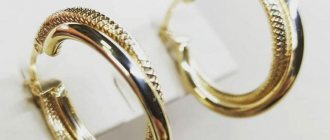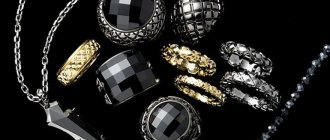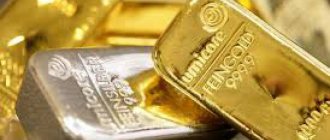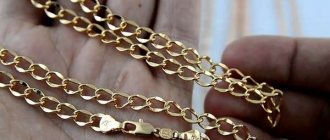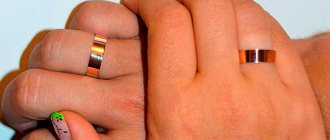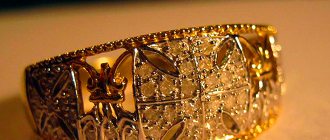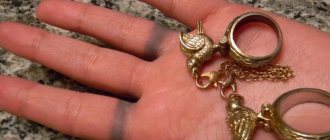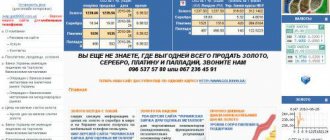Precious metals in microcircuits
The first thing you need to pay attention to is the microcircuits of electronic household appliances. The materials they contain are necessary for the conduction of electric current, the formation of sufficient resistance and the normal functioning of the chips. In order to mine such an amount of gold that you can earn an amount that covers the cost of processing the parts, you need to stock up on a large number of microcircuits.
Soviet-made ceramic capacitors contain tantalum and silver elements, transistors and LEDs contain gold, as do switches, connectors, relays and potentiometers. Metal parts contain many alloys, including:
Precious metals miners often have difficulty buying up chips. After all, the bulk of such Soviet-made devices have already been sold. And in order to extract 5 g of silver and 1 g of gold, you need to sort through at least one thousand parts. In some cases, the actual amount of precious substances differs from that indicated in the directory. Gold and silver content in certain microcircuits:
- K537RF - 40.1 and 71.2 g;
- 1200TSL1 - 43.3 and 115.1 g;
- 2FV2000 - 41.7 g of yellow metal, no silver;
- 530ID7 - 28.5 and 26.7 g;
- KM132RU2 - 34.7 and 52.6 g.
Microchips are rarely chosen for mining precious substances. Several parts on the list contain microscopic fractions of palladium. If the composition contains gold, the chip will have a characteristic yellow tint.
Where are capacitors with precious metals used?
There are different types of devices. They are divided into polar and non-polar. The manufacturing materials are glass, glass ceramics, and synthetic materials. By type of device there are: film, high-voltage, low-voltage, oxide-semiconductor, mica, electrolyte, foil, oxide-metal.
Sell capacitors
There are products in various technologies and equipment: radios, radios, printers, scanners, measuring instruments, and other radio devices.
Capacitors and resistors
Like microcircuits, the content of precious metals in capacitors is higher if they are made in the Soviet Union. In addition to silver and gold, platinum and palladium can be extracted from such elements. But recently, the amount of valuable substances has been decreasing due to the high cost of production. The demands placed on modern products today sometimes preclude the use of traditional materials.
If you are interested in which capacitors contain precious metals, then all parts are divided into several categories depending on the volume of gold, silver and platinum:
- ceramic with the KM brand;
- with a yellow body;
- tantalum;
- with silver coating.
You can get gold and silver from computers, automatic telephone exchanges and electronic devices that were produced in the USSR. For example, in the K 22 5 capacitor the content of precious metals is as follows - 34.2 g of gold and 52.3 g of silver. Tube TVs, tape recorders and other household appliances of that time can also be useful.
Not only capacitors and microcircuits contain valuable elements. They are also obtained from resistors. But they contain a lot of silver, and practically no gold and platinum. Experts pay special attention to Soviet potentiometers of the PTP, 5K, PPML and PPBL series. Models manufactured before 1982 are suitable. It is advisable that they be marked “Rhombus”.
Precious metals are extracted from these parts using a chemical method. You will need to prepare solutions of nitric and hydrochloric acid. A capacitor, microcircuit or resistor is placed in the mixture for 30-40 minutes and wait for the substances to separate. The sediment that appears at the bottom of the container may have a red or brown tint - this is gold. It is collected and washed, then melted into jewelry or other products.
Gold in connectors
Connectors are considered a rich source of precious materials. You can buy them by weight. Both Soviet and imported models are suitable for gold and silver mining. The year of manufacture does not matter. Some radio components contain quite a lot of palladium. In order to find out whether it really is in the composition, the element must be set on fire. If, as a result, dark spots appear on the connector, then you can remove the precious metal.
One kilogram of these parts usually contains up to 25 g of pure gold. Chinese and American connectors are poorer sources, containing five times less precious metals. It is easy to extract the substance from the elements. To do this, you need to prepare a chemical reagent called “Royal Vodka”. It contains a 30% solution of hydrochloric acid and 40% nitric acid. They are mixed in a 3:1 ratio, poured into a pre-cooled container and mixed thoroughly and slowly.
Connectors are placed into the mixture, and the gold is separated from the other elements in their composition. The liquid turns yellow and smells like chlorine. It must be used immediately after production, since after 1-2 days it will lose its properties and become harmful to human health.
The oxidizing agent will separate the gold, platinum and palladium. During operation, the mixture releases vapors that can cause poisoning and internal burns. They must not be inhaled, and the room where the work is carried out must be ventilated. Silver, chromium and zirconium cannot be extracted this way. A thick coating of chloride forms on the surface of these materials. Noble metals will not be affected in this way.
Read also: DIY welding hammer
What capacitors are being bought?
Capacitors with precious metals of Soviet and foreign production are valued. Typically, elements are located on boards and circuits. Valuable types of devices are marked KM. They contain significant amounts of platinum, palladium, silver, gold, and tantalum.
Types of capacitors with precious metals that are accepted at purchase points
Other valuable types of capacitors marked KOMP, KP, KSG, KVK are also available for purchase. The passport of such types of products must indicate the amount of precious metal and full marking. Although in fact, when scrap is handed over, the contents of the precious metal usually decrease. It is important for clients to discuss all the nuances in advance, before the sale.
Most precious metals are found in capacitors of generators and radio signal transmission stations. They contain up to 50 g of pure gold or 8 g of yellow metal. Radio tubes are also a treasure. They are located on the grid near the cathode.
Features of transistors
Not all transistors contain precious metals. But there are some household appliances that contain parts with gold and palladium. Most popular elements:
The minimum amount of gold that can be obtained from them is 10.8 g, the maximum ranges from 26.4 to 33.43 g. Some parts also contain silver in the amount of 273-519 g and a small amount of palladium. Some models contain up to 1 g of platinum.
The content of precious substances is determined by the color of the contacts. If they are yellow, that is gold, red - copper, silver - silver, white - platinum. To extract them, you need to remove the housing from the transistor, disassemble all the parts and clean the insulation from the contacts. Using a chemical method using a solution of hydrochloric and nitric acid, the precious material is isolated and purified.
Application
The main area of application is work in pulsed, alternating and direct current circuits. They can be used in any equipment: communication systems, household, scientific and measuring equipment, industrial equipment - and this is not a complete list of possible applications. How to avoid mixing up KM capacitors during operation? This type of device is marked directly on it and is represented by an alphanumeric index. Therefore, if you want to purchase one such device, you must first find out how it is designated and what it looks like. When this stage has been completed, you should go to a radio equipment store or market to find a capacitor similar in appearance and corresponding to the indicated marking.
Relay characteristics
Specialists of the Soviet Union used high-quality materials to produce household appliances and computers. Precious materials were often used. They are contained in significant quantities in the relay. Miners are recommended to use parts from the following series:
- RP and RES;
- RKN and RPS;
- RKP and RKM;
- RTN and TRSM;
- TRT and TRP.
Additionally, you need to check the relay with an aluminum housing, since it is necessary to reach the contacts. The presence of silver or platinum is determined by their color.
Even in Soviet times, radio amateurs mined gold from electronics. They learned that the significant content of precious metals in the capacitor is the 1st source in terms of their quantity in technology. This method of earning money remains relevant to this day. With the right choice of parts, you can accumulate your own small capital, because gold, since its inception, has always played the role of hard currency.
You don't have to leave home to mine gold It is enough to advertise: “I will buy old radio components .” Samples from past decades contain yellow metal, sometimes in quite significant quantities. By purchasing certain models from suppliers, you can extract valuable raw materials from them.
It can possibly be melted down into ingots, but it would be better into jewelry, for example, rings. There may be problems with the free sale of bullion. “Trinkets” are sold without difficulty. What kind of radio components with gold should you turn to, how to process them in order to get the jewel, then.
Main characteristics
KM capacitors are divided into high-frequency and low-frequency. Depending on their purpose, they belong to one of three groups:
1. This includes those that are characterized by high capacitance stability and low losses.
2. Those that cannot boast of what group No. 1 has.
3. The same as from point No. 2, but there is a slight difference. They are designed to operate in low-frequency circuits.
The greatest interest when choosing is provided by a dozen basic electrical parameters and over twenty-five operational characteristics. There are over 60 of them in total.
Radio components containing gold
Gold-bearing deposits are developed if the content of the precious element is at least 1 gram per ton of rock. In one chip there is from 1 to 5 percent yellow metal. The leads of the part, enclosed in a ceramic case, are coated with gold.
If it is made of plastic, the content of valuable raw materials is less - from 0.2 to 1 percent. In transistors, the precious element is about 2 percent. The substrate located under the conductor is made of gold
But capacitors break all records. Their size is approximately equal to a three-liter jar. One such part contains approximately 8 grams of yellow metal. In addition, there is also 50 grams of silver. However, only capacitors used in military equipment - generators and radio signal transmission stations - are equipped with expensive filling.
Some gold can also be extracted from radio tubes. The precious element is deposited on a grid located near the cathode. The latter, when the lamp is operating, heats the grid. When exposed to heat, it begins to release electrons. This disrupts the operation of the product.
Therefore, the radio component needs to be coated with gold . Spraying from it is also found on the legs of objects of consecration, but this only applies to old samples, decades old.
Several microns of precious raw materials were previously applied to connectors of all types of semiconductors, such as diodes, optocouplers, thyristors, and zener diodes. Gold is rarely found in resistors. However, some of them, along with silver, also contain a little yellow metal.
These are the standards by which radio components were manufactured in the USSR in the 70s and 80s of the last century. Gold is also found in modern radio components . However, to extract hundredths of a gram from an item for which tens, or even hundreds of thousands of rubles were paid. Let the old parts be used - that's another matter.
Most often, radio components containing gold are found in old-style computers, switching devices, and radio equipment. Electronic computing units of the SM and CE series should be of primary interest to applicants. One such machine contains from 0.2 to 10 kilograms of gold. Some military equipment can boast of the same thing.
Read also: How to properly solder headphone wires
Beginners will find it useful to list not only the general names of radio components equipped with gold “filling,” but also specific model designations. So:
Transistors KT201, KT203, KT3102, KT301, KT306, KT605. All of them are equipped with golden colored legs.
KT802, 808, 803, 809, 812, 908. We need samples produced before 1986. In later models gold was not used.
KT907,904, 606. Externally they have no gold elements and no yellow color. However, valuable raw materials are actually present.
But KT602, 604, 611, 814, 815, 816, 9909 have gold cases.
Relay RES9, 10, 15, 22, 34, RPS24, 32, 34, RKG15.
Microcircuits K142EH, K50, K56PY2, AOT101, K145, also known as the “white spider”.
Chips K133, 134, 178, 249, 564, 565, K140, 157, 217.
Diodes of the D226 series and similar ones.
Capacitors Km3, 4, 5, 6, 10, 11, 12, 13, 14, 15, 16, 17, 52-1, 52-7, K53-1, 53-6, 53-7, 53-10, 53 -15, 53-16.
Resistors PTP1, 2, PLP2, 6, PP3-40, 3-41, 3-43, 3-44, 3-45, 3-47, KSP1, 4, KSU1, KSD1, KPU1, KPP1, SP5-1, 5 -2, 5-3, 5-4, 5-14,5-15, 5-16, 5-17, SP3-19, 3-44.
Connectors SNP59-64V, SNP59-96R, GRPPM7-90Sh, RPPG2-48.
Switches TV1, P23G, Pg2-5, 2-6, 2-7, 2-10, P1T3-1V, PR2-10, PKN8, PT33-26, PP8-6, PPK2.
Modifications of KM capacitors
The following modifications of capacitors were made: KM-3, KM-4, KM-5, KM-6.
KM-4, KM-5, KM-6 - there can be 1 or 2 types, KM-3 - only 2 types.
Design options:
- non-isolated, multi-directional terminals: KM-3a, KM-4a, KM-5a - non-isolated, unidirectional terminals: KM-3b, KM-4b, KM-5b - isolated, unidirectional terminals: KM-3b, KM-4b, KM- 5b, KM-6(a, b) - unprotected: KM-3v, KM-4v, KM-5v
Range of nominal capacities:
KM-3 680 pF - 22 nF KM-4 16 pF - 47 nF KM-5 16 pF - 0.15 µF KM-6 120 pF - 2.2 µF
Distribution of CM by rated voltage value (V) and TKE groups:
| TKE | P33 | MPO | M47 | M75 | M750 | M1500 | H30 | H50 | H90 |
| KM-3 | 250 | ||||||||
| KM-4 | 250 | 250 | 250 | 250 | 160 | 160 | 100 | ||
| KM-5 | 160 | 160 | 160 | 160 | 100 | 100 | 50 | 50 | |
| KM-6-a | 50 | 50 | 50 | 50 | 35 25 | 35 25 | 35 25 | 35 25 | |
| KM-6-b | 50 | 50 | 50 | 50 | 35 25 | 35 25 | 35 25 |
How to extract gold from radio components
Let's try to figure out how to extract gold from radio components . The solvent for the precious metal is a mixture of hydrochloric and sulfuric acids. The proportions are 3 to 1, respectively. Liquids of a certain density must be mixed.
The indicator of sulfuric acid should be 1.8 grams per cubic centimeter, hydrochloric acid - 1.19 grams per cubic centimeter. The separation of gold from the base will not be complete unless the solution is heated to 60, 70 degrees Celsius.
Only the part should be lowered into the hot mixture. Afterwards, add a small amount of nitric acid to the container. The resulting solution is known as “aqua regia.” It dissolves almost all elements, including gold. The microcircuit, or other element, will melt in the mixture, which should then be precipitated with a reducing agent.
The number of radio components and the content of valuable raw materials in them should be taken into account. Typically, 200–300 grams of gold-plated surface requires one and a half liters of nitric acid. The equipment should be disassembled as much as possible, glass elements and areas without precious coating should be separated. They will “take” the chemical solution onto themselves, and then more of it will be needed. It is advisable to lower only the parts themselves with yellow metal into the medium.
At room temperature, without heating, metal can be isolated from a mixture of acids by electrolysis. It is only suitable for working with copper and brass parts. A current with a density of 0.1 to 1 A/dm2 is passed through the solution. Lead or iron is used as the cathode. The gold separation procedure is completed if the current strength begins to drop sharply.
You can buy ready-made compositions for separating precious metals in special stores. It is also possible to establish cooperation with small chemical industry enterprises. Many Internet sites also offer reagents and deliver products to your home. The methods for extracting gold from radio components described above are applicable at home.
Costs of separating gold from radio components
One liter of reagents costs approximately 300 rubles. 1 gram of isolated gold is valued at approximately 2500-3000 rubles. To get about 3 grams of yellow metal from KT605 transistors, for example, you will need 100 parts. Each of them contains 27 micrograms of valuable raw materials.
You can buy transistors for 15-20 rubles apiece. Spend about 2000 rubles, you will receive approximately 8000-9000 thousand. It is necessary to calculate the profitability of an enterprise. “Recycling” of some radio components is unprofitable.
Absolutely everywhere there are advertisements “buying radio components”, “I will buy expensive radio components”, “I will buy Soviet transistors, microcircuits, capacitors and blah blah blah...”. But why, who needs these outdated microcircuits, large transistors, lamps, capacitors?
I think most people are already aware - precious metals are gold, silver, platinum, palladium. Yes, yes, that is why people who are far from radio engineering and electronics buy them in kilograms. Let's start with the most expensive elements. I present to your attention capacitors.
Attention, the article was written back in 2013. Now prices are many times higher!
Precious metals in capacitors
The price for 1 kg of such capacitors reaches up to 70,000 rubles! Think about this amount 0_0. If you collect 2 kilograms of these condensers in a year, you can not work for a whole year :-). And I’ll tell you a secret that some people do just that. Some grandmother or grandfather has an old Soviet radio, an antediluvian TV or radio lying gathering dust. Buyers go from house to house and buy up this equipment for pennies, and sometimes even for nothing, and, of course, bite off and solder off expensive radio elements. But why are these capacitors the most expensive? They contain the most expensive precious metals - platinum and gold.
Read also: How to make a gas burner from a cutter
Prices at the end of 2012 for precious metals: gold - 1620 rubles per gram, silver - 30 rubles per gram, platinum - 1500 rubles per gram, palladium 700 rubles per gram. Prices are slightly rounded for ease of perception. Such capacitors contain the most platinum, according to the Internet, up to 20 grams per 1000 pieces. Now they are quite difficult to find.
Also from this series are capacitors KM-5D. Their price can reach up to 40,000 rubles per kilogram.
are also of great interest . Their price reaches up to 35,000 rubles per kilo.
And these are the ones that say N902M2 . Their price is up to 30,000 rubles per kilo.
As you can see, the price range of capacitors greatly depends on how many milligrams of precious metals are contained in each of them. They also accept a lot of types of other capacitors, but I think you shouldn’t bother with them, since their price is a penny.
To summarize, buying radio components consisting of green and red capacitors is a profitable business.
Precious metals in microcircuits
There is such freedom here. 99% of any microcircuits are purchased. They can be in round, ceramic, planar, or metal cases. But, I think it would be more advisable to focus on the most highly profitable microcircuits. There is only one rule here: if it smells of gold, then such a microcircuit is accepted without any problems. These may be gold-plated contacts or a housing. So, I present to your attention the highest paying microcircuits:
133LA1 – up to 12 rubles per piece
133LA8 – up to 26 rubles per piece
542ND1 – up to 28 rubles per piece
K5ZhL014 – up to 55 rubles per piece
K5TK011 – up to 55 rubles per piece
Keep in mind - these are just some of their names. The microcircuits may be completely different in name, but if it is similar to the microcircuits that I showed in the photo, then they will also be accepted for the same price. As you can see, their terminals and housings are gold plated. In short, if you see any of this, immediately take care and save it ;-). This also includes computer processors.
In the photo below are microcircuits that are accepted for a good price, regardless of what is written on them. The golden color makes itself felt.
The remaining microcircuits are not worthy of attention as a sale for precious metals, since they cost pennies, so let’s move on to the next group of radio components.
Precious metals in transistors
Let's also consider the most expensive of them.
KT909A-B – up to 30 rubles per piece
KT904,907,914 are “sharpened” for a yellow bolt – up to 40 rubles per piece
KT970A – up to 30 rubles per piece.
KT602-604 and the like with yellow legs. Price per piece – up to 30 rubles.
As you noticed, all presented transistors are gold plated.
Other radio components
Variable resistors are in great demand. Their price varies from 5 to 10 rubles per piece.
Some types of relays. For example RES-7. Its price is up to 500 rubles per piece.
Only certain types of relays of certain years and series are accepted. Anyone who still wants to hand over relays, I advise you to scour the internet and know exactly which relays of which year are accepted.
And, of course, there are connectors with gold-plated contacts. If you see a yellow glow on such connectors, you can safely return them. Prices here can also vary from 50 kopecks to 3 rubles per contact. Multiply the price by the number of contacts - that’s the price of the connector.
And also Soviet lamellas for about 1000 rubles per kilo. For those who don’t understand what lamellas are, remember the Dandy cartridge

